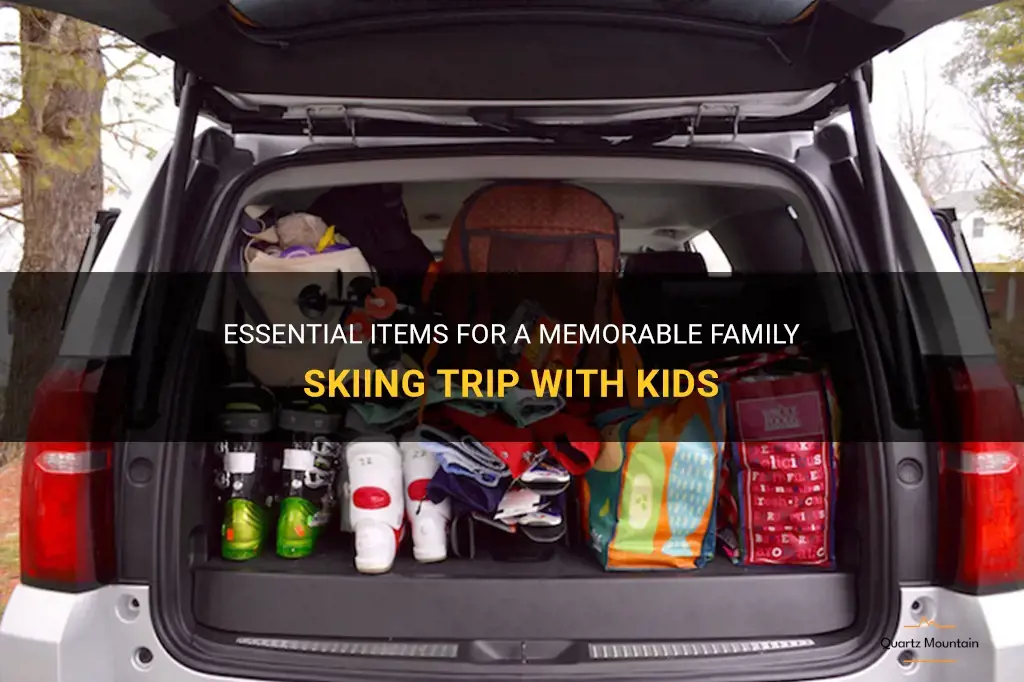
Planning a family skiing trip with kids can be both exciting and overwhelming. As you prepare to hit the slopes and create lasting memories in the snow, it is crucial to ensure that you have all the essential items to make your trip a success. From proper clothing and gear to safety equipment and entertainment, this guide will help you pack everything you need for a memorable family skiing adventure with your little ones. So, buckle up and get ready to glide through the snowy wonderland with ease and style!
| Characteristic | Value |
|---|---|
| Warm clothing | Thermal layers, hats, gloves, mittens, scarves, thermal socks |
| Ski equipment | Skis, ski boots, ski poles, helmets, goggles |
| Snow gear | Snow pants, snow jackets, snow boots, snow gloves |
| Protective gear | Knee pads, elbow pads, wrist guards, back protectors |
| Sun protection | Sunscreen, sunglasses, lip balm with SPF, hats |
| Snacks | Energy bars, fruit, granola bars, water bottles |
| Entertainment | Books, games, tablets, portable DVD player |
| Extra clothing | Extra layers, spare gloves, spare socks, spare hats |
| First aid kit | Band-aids, pain relievers, blister pads, antiseptic wipes |
| Skincare products | Moisturizer, lip balm, hand cream, face mask |
What You'll Learn
- What essential clothing items should I pack for my kids when skiing?
- Are there any specific items or equipment that I need to bring for my kids when skiing?
- How many layers of clothing should I pack for my kids when skiing?
- Are there any special considerations for packing food or snacks for kids when skiing?
- What other non-clothing items should I pack for my kids when skiing, such as sunscreen or lip balm?

What essential clothing items should I pack for my kids when skiing?
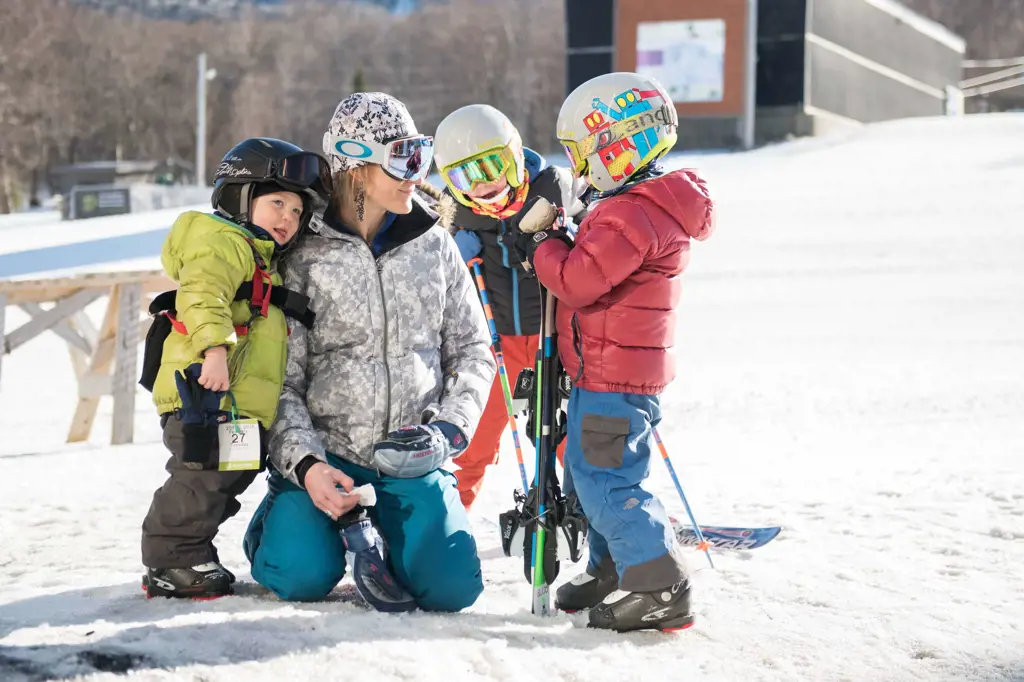
When planning a family ski trip, it's important to ensure that your children are properly dressed to stay warm and comfortable on the slopes. Packing the right clothing items can make a big difference in their overall skiing experience. Here are some essential clothing items you should pack for your kids when skiing:
- Thermal Base Layers: A good set of thermal base layers is essential for keeping your kids warm on the slopes. These layers will help regulate their body temperature by wicking away moisture and insulating their bodies. Look for base layers made of a high-performance fabric like merino wool or synthetic blends.
- Insulated Jacket and Pants: Invest in a quality insulated jacket and pants for your kids. These outer layers will provide an extra layer of protection against the cold and wind. Look for jackets and pants with waterproof and breathable materials to keep your kids dry and comfortable throughout the day.
- Ski Socks: Proper ski socks are crucial for ensuring your kids' feet stay warm and dry. Choose socks made of a moisture-wicking fabric that fits snugly but not too tight. Avoid cotton socks, as they tend to retain moisture, leading to cold and uncomfortable feet.
- Gloves or Mittens: Protect your kids' hands from the cold with a pair of insulated gloves or mittens. Look for gloves with a waterproof and breathable outer shell and a warm lining. Mittens tend to be warmer than gloves as they allow the fingers to share heat.
- Neck Gaiter or Balaclava: A neck gaiter or balaclava is a must-have accessory for keeping your kids' faces and necks protected from the cold. Look for ones made of a moisture-wicking and breathable material that will keep them dry and comfortable.
- Helmet: Safety should always be a priority when skiing, especially for children. Make sure your kids have a properly-fitted helmet to protect their heads in case of a fall or collision. Look for helmets with adjustable straps and ventilation for comfort.
- Goggles or Sunglasses: Protect your kids' eyes from the sun and glare with a pair of ski goggles or sunglasses. Goggles offer better protection and visibility in snowy conditions, while sunglasses are better for sunny days. Look for ones that provide 100% UV protection.
- Ski Boots and Bindings: Properly fitting ski boots are crucial for your kids' comfort and safety. Make sure they have the correct size and are properly adjusted. Familiarize yourself with the ski bindings' settings and make sure they are properly adjusted for your children's weight and ability level.
Remember to dress your kids in layers, so they can adjust their clothing according to the weather conditions. It's also important to teach your kids about the importance of staying hydrated and using sunscreen, even on cloudy days. By packing these essential clothing items and following these tips, you'll ensure that your kids have a safe and enjoyable skiing experience.
Pack Like a Pro: Essential Items for Trailfest
You may want to see also

Are there any specific items or equipment that I need to bring for my kids when skiing?
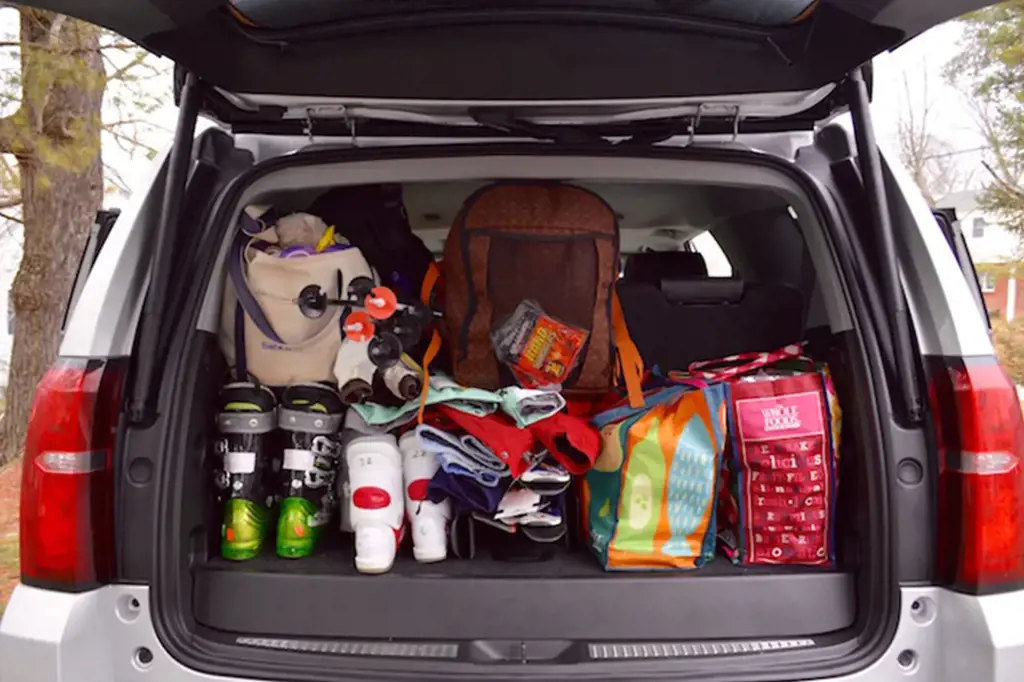
When planning a ski trip with your kids, it's important to make sure you have all the necessary items and equipment to ensure their safety and comfort on the slopes. Skiing can be a great activity for children to enjoy, but it's important to be prepared and have the right gear.
Here are some specific items and equipment that you should bring for your kids when skiing:
- Ski clothing: Make sure your kids have proper ski clothing, including waterproof and insulated jackets, pants, and gloves. Layering is key to keeping them warm, so pack base layers, such as long underwear or thermal leggings, as well as mid-layers like fleece or sweaters.
- Helmets: Safety should be the top priority when skiing with kids. It's crucial to have properly fitting helmets for your children to protect their heads in case of a fall or collision. Make sure the helmet covers the forehead and securely fastens under the chin.
- Ski boots: Properly fitting ski boots are essential for your child's comfort and safety on the slopes. Renting ski boots is often the best option for kids, as their feet can grow quickly. Ensure that the boots fit snugly but not too tight, and that they provide good ankle support.
- Skis and poles: Depending on the age and skill level of your child, you may need to rent or purchase skis and poles. It's important to choose the right size skis for your child's height and weight. Many ski shops or rental locations can help you with sizing and fitting.
- Goggles or sunglasses: Protect your child's eyes from the sun, wind, and snow glare by equipping them with goggles or sunglasses. Goggles are recommended for younger children as they provide better coverage and protection.
- Ski socks: Having the right socks can make a big difference in your child's comfort on the slopes. Look for ski-specific socks that are made of a moisture-wicking material to keep their feet dry and warm. Avoid cotton socks, as they can get wet and cold easily.
- Sunscreen: Even in cold temperatures, the sun's rays can be intense, especially at higher altitudes. Apply a broad-spectrum sunscreen with a high SPF to protect your child's skin from harmful UV rays.
- Snacks and water: Keeping your kids hydrated and fueled is important for their energy levels throughout the day. Pack some lightweight and easy-to-eat snacks such as fruits, granola bars, or trail mix, as well as a water bottle.
Remember to also check the weather conditions and dress your kids appropriately. Layering is key, as they can always remove or add layers as needed. It's always a good idea to have an extra set of dry clothes in case they get wet. Lastly, don't forget to pack some entertainment for the downtime, such as a small puzzle or coloring book, to keep your kids occupied during breaks.
Essential Items to Pack for a Memorable Two-Week Trip to Hawaii
You may want to see also

How many layers of clothing should I pack for my kids when skiing?
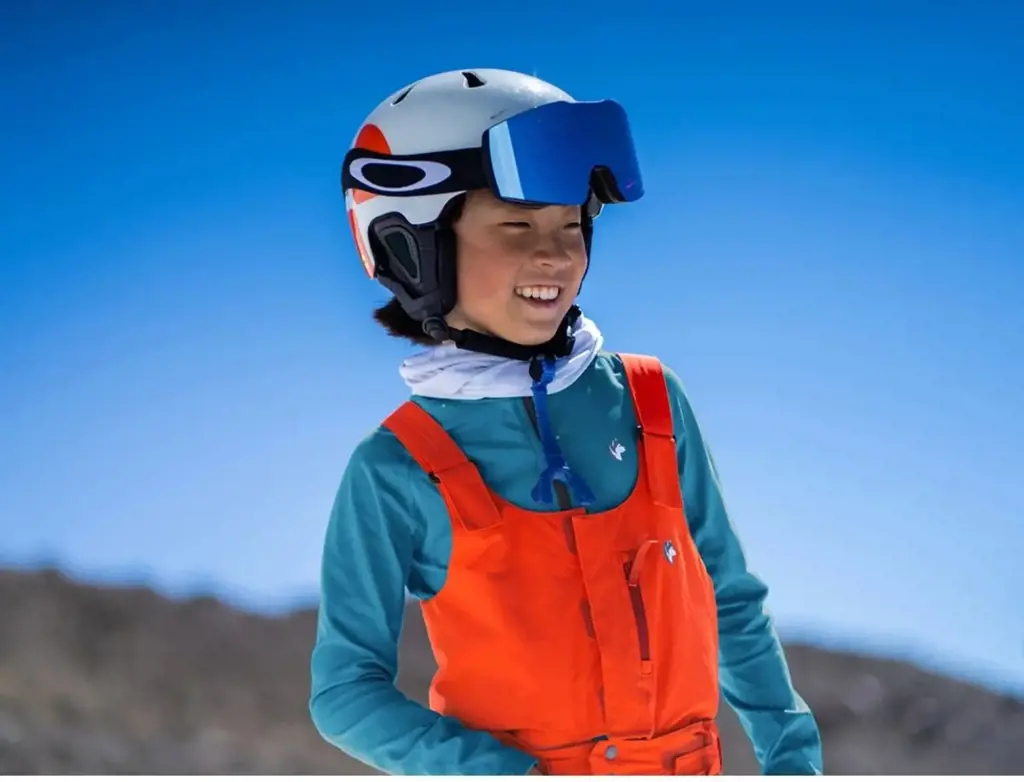
When it comes to skiing, it's important to dress your kids appropriately to ensure they stay warm and comfortable on the slopes. Layering is key to regulating body temperature and providing insulation, especially in cold weather conditions. So, how many layers of clothing should you pack for your kids when skiing? Let's find out.
- Base Layer: The base layer is the first layer of clothing that goes directly against the skin. It should be made of a moisture-wicking material such as merino wool or synthetic fabrics like polyester or nylon. This layer helps to keep your child dry by wicking away sweat and moisture from the skin, preventing them from feeling cold and damp.
- Mid-Layer: The mid-layer provides insulation and helps retain body heat. It can be a fleece jacket, sweater, or a light down jacket. The mid-layer should be breathable and provide enough warmth without being too bulky. It's important to choose a mid-layer that allows freedom of movement and fits well under a ski jacket.
- Outer Layer: The outer layer, also known as the shell layer, provides protection from wind, snow, and water. A waterproof and windproof ski jacket and pants are essential to keeping your child warm and dry. Look for garments with sealed seams and adjustable cuffs or hems to ensure a snug fit that keeps out the elements.
- Accessories: Don't forget to pack some essential accessories to keep your kids warm and comfortable while skiing. These may include a warm hat or helmet liner, waterproof gloves or mittens, thermal socks, and a neck gaiter or scarf to protect the neck and face from cold winds.
Remember, the number of layers your child needs may vary depending on the weather conditions and their activity level. If it's particularly cold, you may want to add an extra mid-layer or consider a thicker down jacket. On warmer days, your child may only need a base layer and a shell layer.
It's also important to consider your child's comfort and mobility. Avoid packing too many bulky layers that may restrict movement or make them uncomfortable. Opt for lightweight and versatile clothing that can be easily layered or removed as needed.
Lastly, don't forget to pack extra layers and a change of clothes in case your child gets wet or sweaty. It's better to have too many layers and remove them if necessary, rather than not having enough and risking your child's comfort and well-being.
In conclusion, when packing for your kids to go skiing, it's recommended to include a base layer, mid-layer, outer layer, and essential accessories. However, the number of layers may vary depending on the weather conditions and activity level. The key is to ensure your child stays warm, dry, and comfortable while enjoying their time on the slopes.
The Essential Items to Pack for an Adventure in Beautiful Rwanda
You may want to see also

Are there any special considerations for packing food or snacks for kids when skiing?
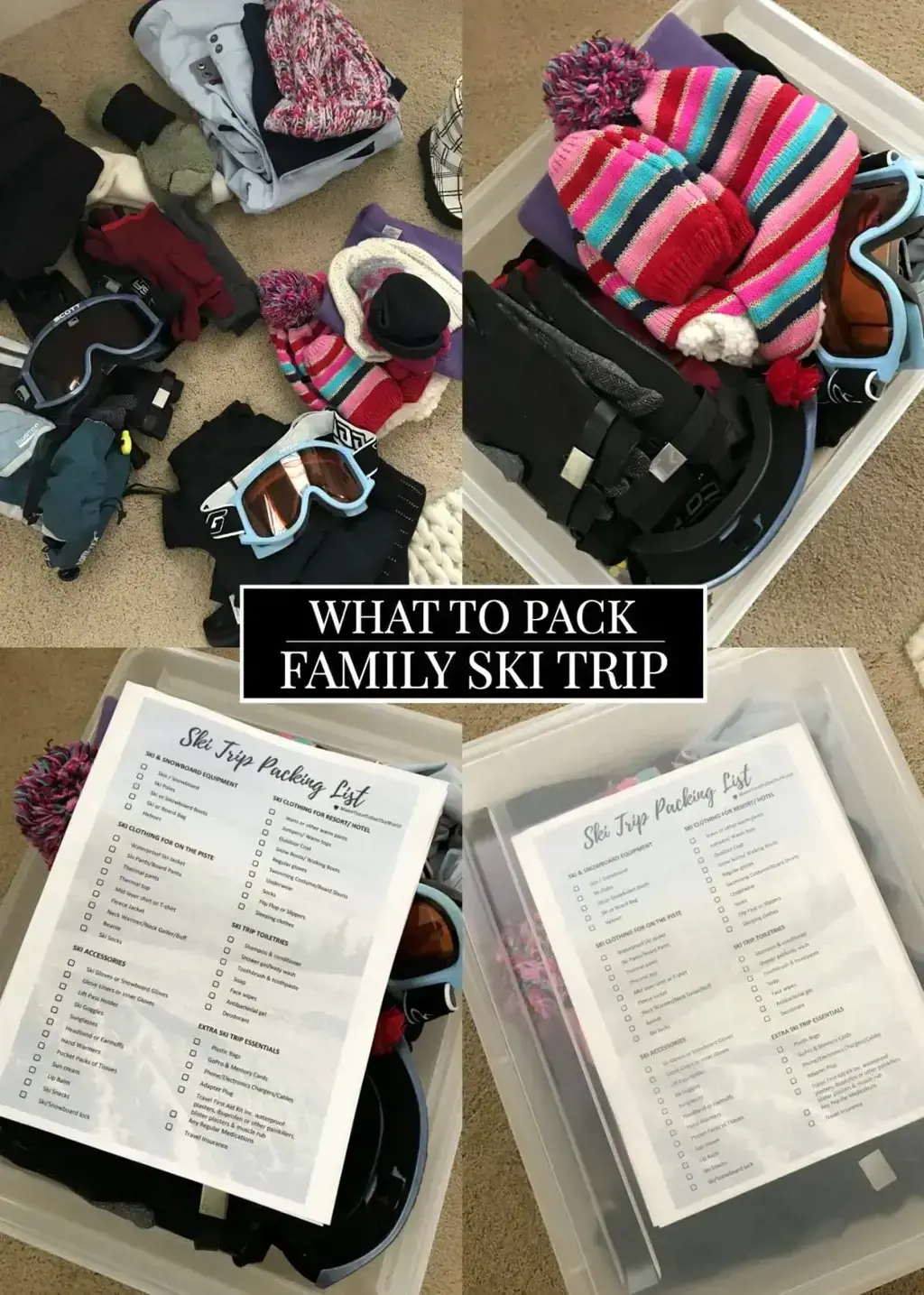
When it comes to skiing, it's important to pack the right kind of snacks and food to keep your kids energized and satisfied on the slopes. Here are some special considerations to keep in mind:
- Nutritional balance: Skiing is a physically demanding activity, so it's important to pack snacks that provide a good balance of carbohydrates, protein, and healthy fats. Carbohydrates will provide quick energy, protein will promote muscle recovery, and fats will help sustain energy levels. Good options include granola bars, trail mix, beef jerky, nut butter packets, and cheese sticks.
- Hydration: Skiing can be dehydrating due to the dry and cold air, as well as the physical exertion. It's crucial to pack plenty of fluids, such as water, sports drinks, or fruit juices, to keep your kids hydrated throughout the day. Preparing a thermos of hot chocolate or soup can also be a comforting treat for breaks.
- Easy to eat and carry: Kids will likely want to eat on the go, so choose snacks that are easy to eat and carry. Avoid foods that require utensils or are messy to eat. Instead, opt for portable options like pre-cut fruits and vegetables, energy bars, or sandwiches. Individual snack packs or reusable containers are ideal for portion control and convenience.
- Allergies and dietary restrictions: If your child has any food allergies or dietary restrictions, it's crucial to pack snacks that are safe for them to consume. Be sure to read food labels carefully and choose options that are labeled as allergen-free or suitable for their specific needs. Packing homemade snacks using ingredients you know are safe is also a good option.
- Temperature considerations: Depending on the weather conditions, you may need to take temperature considerations into account when packing food for your kids. In cold weather, pack foods that won't freeze or become too cold to eat, such as crackers, pretzels, or dry fruits. On the other hand, if it's particularly warm, choose foods that won't spoil easily, like fresh fruits and vegetables, yogurt, or sandwiches with non-perishable fillings.
- Snacks for energy boosts: Skiing can be physically taxing, especially for kids. Pack snacks that can provide quick energy boosts when needed. Options like energy bars, dried fruits, nuts, or mini sandwiches with peanut butter and jelly can help recharge your child's energy levels between runs.
Overall, packing snacks and food for your kids when skiing should prioritize nutritional balance, hydration, convenience, and personal dietary needs. By considering these factors, you can ensure that your children have the fuel they need to enjoy a day on the slopes. Remember to pack enough snacks to last throughout the day and encourage your kids to take breaks and eat regularly to maintain their energy levels.
The Essential Checklist for Packing a Cold Lunch
You may want to see also

What other non-clothing items should I pack for my kids when skiing, such as sunscreen or lip balm?
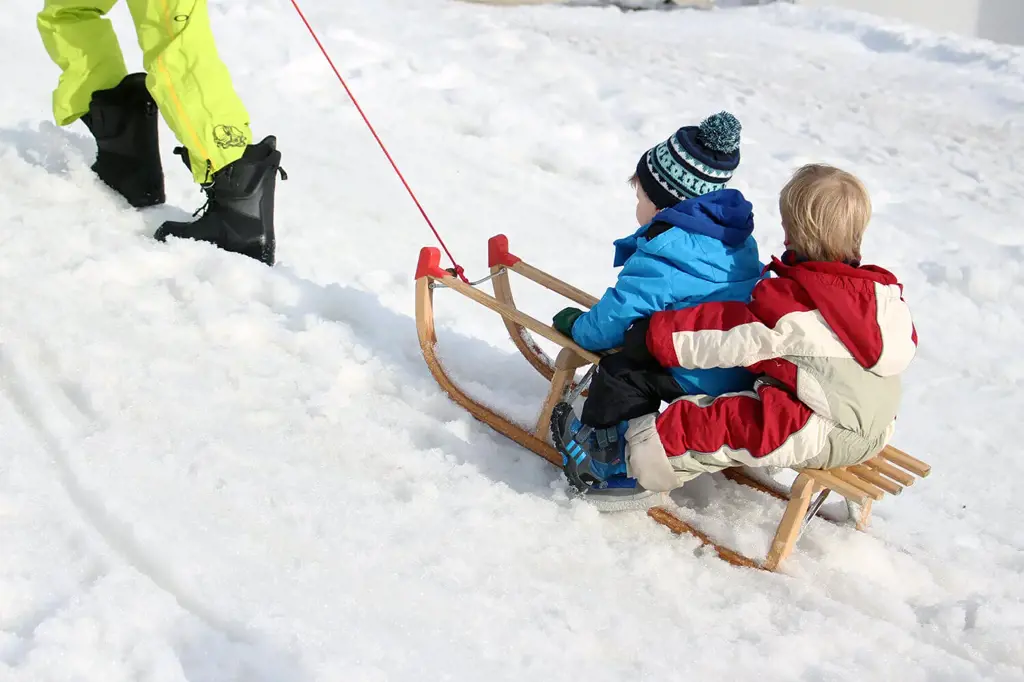
When you're planning a skiing trip with your kids, it's important to pack more than just warm clothing. Other non-clothing items can be essential for their comfort and protection on the slopes. Here are some items you should consider packing:
- Sunscreen: Even though you'll be in a cold environment, the sun's rays can still be strong on the slopes. Make sure to pack a high SPF sunscreen and apply it regularly to your child's exposed skin, especially their face, neck, and ears. This will help prevent sunburn and long-term skin damage.
- Lip balm: The combination of cold temperatures and wind can quickly lead to dry and chapped lips. Pack a moisturizing lip balm with SPF to protect your child's lips from getting too dry or sunburned. Look for a balm that is specifically designed for winter sports, as it will offer better protection against the elements.
- Goggles: Good quality goggles are a must for skiing. They not only protect your child's eyes from wind, snow, and debris, but also shield them from harmful UV rays. Look for goggles with UV protection and anti-fog features to ensure optimal visibility on the slopes. Make sure the goggles fit well and have a comfortable strap that stays securely in place.
- Helmets: Safety should always be a top priority when skiing with kids. Invest in a well-fitting helmet for each child to protect their head in case of falls or collisions. Look for certified helmets that meet the safety standards of professional ski organizations. Make sure the helmet covers the forehead, sides, and back of the head for maximum protection.
- Hand and foot warmers: Cold hands and feet can quickly ruin your child's skiing experience. Pack disposable hand and foot warmers to keep their extremities cozy and comfortable. These can be easily slipped into gloves, mittens, boots, or socks to provide hours of warmth. Make sure to follow the instructions on how to activate and use these warmers properly.
- Snacks and water: Skiing can be physically demanding, and your kids will need to refuel regularly. Pack healthy snacks like energy bars, nuts, fruits, or sandwiches to keep their energy levels up. Also, make sure to carry a water bottle for each child to keep them hydrated throughout the day.
- First aid kit: Accidents can happen on the slopes, so it's always a good idea to have a compact first aid kit on hand. Include items like adhesive bandages, blister pads, antiseptic wipes, pain relievers, and any personal medications your child may need.
Remember to involve your children in the packing process so they understand the importance of these items and how to use them. This will help them take responsibility for their own comfort and safety while skiing. By being prepared with these non-clothing items, you can ensure that your kids have an enjoyable and safe skiing experience.
The Essential Packing List for a Holiday in Dubai
You may want to see also
Frequently asked questions
When packing for skiing with kids, it's important to take into consideration the cold weather and the activities they will be participating in. Here are some essentials you shouldn't forget:
Layering is key when it comes to skiing with kids. Make sure to pack thermal base layers to keep them warm, followed by a fleece or down jacket for insulation. Waterproof and insulated pants are also a must. Don't forget warm socks, gloves, and a hat or helmet to keep their heads warm.
If your kids are beginners, you may want to consider renting ski equipment instead of purchasing it. However, you will still need to pack a helmet, goggles, and gloves for them. It's also a good idea to bring a backpack with snacks, water, and extra layers in case they get cold.
In addition to ski clothing and equipment, there are a few other essentials you should pack. This includes sunscreen to protect their skin from the sun's rays, lip balm to prevent chapped lips, and a small first aid kit for any minor injuries. It's also important to pack plenty of snacks and water to keep them energized throughout the day.
For younger kids, it's important to pack extra clothing and layers in case they get wet or cold. Diapers, wipes, and extra mittens are also essential. You may also want to consider bringing a stroller or carrier for when they need a break from skiing or if they get tired and need to be carried.







